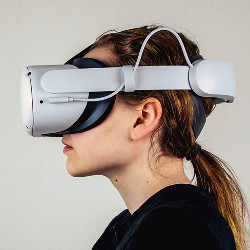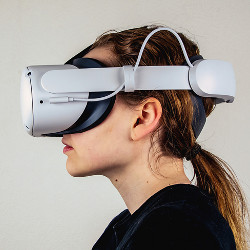
For decades, virtual reality (VR) has seemed like a futuristic dream that is just around the corner, but never reaches its full potential. This time, however, might really be different. Recent advances in the power of VR hardware, notably the headsets and processors used to produce realistic VR experiences, suggest that VR is finally powerful enough and cheap enough to go mainstream.
VR broadly refers to immersing yourself in a three-dimensional (3D) digital world using sophisticated hardware and software. While a video game is experienced through a screen, VR often is experienced through a headset that shuts out the external world and transports you to a virtual one. It can also be experienced through room-sized systems that use special projectors and glasses to create VR experiences.
Historically, VR has relied on clunky headsets, expensive computers, and complicated peripheral hardware to produce immersive experiences. VR in various forms has been commercially available since the 1990s, but the technology has been widely criticized as too expensive, too complicated, or too imperfect to produce powerful, affordable virtual experiences that inspire consumers to open out their wallets.
That is beginning to change. Today, powerful commercial VR headsets are sold by Sony, Facebook, HTC, and other major technology players. Sophisticated augmented reality (AR) devices (like your smartphone and Google Glass) are available from the likes of Google, Apple, and Microsoft. The market for VR is growing accordingly, with research firm Marketsand-Markets forecasting industry growth to reach $20.9 billion in 2025, from $6.1 billion in 2020.
Why is VR (finally) having its day in the sun?
It all comes down to better hardware. VR heavyweights now are able to produce headsets that are cheaper and more powerful than models from just a few years ago. As a result, consumer demand for headsets is rising, driving more innovation and investment in VR hardware. Companies are even researching entirely new techniques and designs to make the next generation of VR hardware so light and powerful that it transforms one’s daily life.
“Over time, we would like a device that is nearly the size of your reading glasses or sunglasses, but performs all of the functions of your smartphone, tablet, PC, and even TV, and enables new, 3D (three-dimensional) and spatial functions,” says Siddharth Saxena, founder and CEO of Oblix VR, a VR software startup.
That day might not be far off.
Better Hardware, Better VR
The top three players in VR headsets by sales are Sony, Facebook, and HTC, according to research provided by Statista. In 2019, 5.7 million VR headsets were shipped, according to research from SuperData.
Back in 2016, commercial VR systems required users to connect a headset, controllers, and sensors to an external high-end computer, says Saxena. “This was an expensive, bulky, and inconvenient setup,” he says.
Today, however, systems like Facebook’s Oculus Quest 2 are all-in-one VR platforms with built-in processors that require no external computer at all. This represents a huge leap forward from just a few years ago, says Bill Myers, director of Emerging Technology at S3 Technologies.
In 2017, Myers started a VR arcade that offered consumers access to sophisticated VR stations. Each station used an HTC Vive headset and a high-end computer, which cost a total of $2,500 at the time. Now, he says, consumers can experience the same level of VR immersion with a headset like those available today for just a few hundred dollars.
Why the big jump forward?
In Myers’ view, VR has hit a consumer tipping point. By 2016, the technology finally was good enough and cheap enough (though still limited to those with deep pockets) that consumer demand drove continued progress. Companies were incentivized to manufacture more VR headsets. Suppliers improved their tooling and lensing capabilities to serve demand, and better processing power allowed developers to create truly immersive experiences.
“Now, when a developer sits down to create an experience, it doesn’t have to be what the previous generation was, which was a lot of low-polygon graphics,” says Myers. This is leading to higher levels of performance expected from consumer headsets, and growing consumer demand.
“With advances in inside-out tracking and improved chipsets like the Qualcomm XR2 [the chip used in the Quest 2], the standard for simple, portable VR is now a lot higher,” says Angel Say, CEO and cofounder of Resolve, a company that uses VR to help construction companies review building designs faster and more economically. “Receiving a VR headset as a gift used to be a burden if you didn’t have the right-specification PC or knowledge to set it up; now, it’s as easy as unboxing and setting up a phone for the first time.”
This was not the case when you had to install desktop software, install drivers, calibrate sensors, and deal with bulky peripherals, says Say. “Standalone VR headsets are enabling anyone to pick up a VR headset and, within 15 minutes, be up and running.”
While hardware has come a long way in a few short years, true mass adoption will only come by further reducing the size of devices while maintaining or improving capabilities, according to Saxena. “I don’t think we’re quite where we need to be for mass adoption, but we’re close,” he says.
Research teams are trying to get VR over the finish line.
The Next Generation
Despite advancements in processing power and price, today’s VR hardware is still limited. Sony’s Playstation VR headset, a popular model, weighs more than 1.3 pounds. The heaviest of the most popular headsets, the Valve Index, weighs almost two pounds. Researchers are trying to get around weight constraints with designs that use innovative techniques and materials.
In 2020, Facebook Reality Labs researchers Andrew Maimone and Junren Wang released a paper outlining how holographic optics could be used to create ultra-lightweight VR headsets.
In the paper, titled “Holographic Optics for Thin and Lightweight Virtual Reality,” Maimone and Wang outline the problem facing today’s headsets. Commercially available headsets use “curved optics of solid glass or plastic, which has limited designs to goggles-like form factors.” While goggle-like VR headsets have become lighter and slimmer, they’re still relatively heavy and bulky. The researchers suggest using a combination of new optical design techniques to overcome the problem.
One such technique is polarization-based optical folding, a way to design lenses so light bounces in the right way to the human eye so on-screen images are displayed properly—but the light doesn’t need to physically travel as far as it does in traditional optics. That makes the space needed for VR optics smaller.
The other technique under consideration is holographic optics, an optics technology that “bends light like a lens but looks like a thin, transparent sticker,” according to Facebook’s summary of the research. Holographic optics replace glass or plastic lenses, making the resulting VR headset much lighter.
In fact, these advances could make the VR headsets of tomorrow, with proposed designs less than 10mm in thickness. While still in the prototype phase, the research suggests a possible approach to VR that almost entirely eliminates the need for bulky hardware.
That means the future of VR hardware could actually be closer to that of augmented reality (AR), experts say. With the ability to project immersive imagery through thin, lightweight lenses, the lines between the virtual world and the real one could get extremely blurry.
The new proposed technology from Facebook actually controls the light within a thin lens. That can theoretically solve the issue of external light interfering with simulated images projected to the user, which could further reduce barriers to integrating VR and AR. This is important because, as Facebook chief scientist Michael Abrash explains, “Even when AR is something that everybody uses, 99% of the photons that hit your eyes or your retinas are actually still going to come from the real world.”
“We’re already seeing glimpses of VR devices converging with AR,” says Say. “Being able to toggle between being completely immersed in a digital world and overlaying digital info on the real world is really powerful.”
It’s a future that VR hardware leaders are actively exploring.
“Facebook is in a unique position from a hardware standpoint because they are producing both AR and VR headsets simultaneously,” says Myers. He points to the company’s partnership with Ray-Ban to release a pair of smart glasses. The product won’t have AR features to start, but is seen as the first step toward Facebook’s Project Aria (announced at the same time), an initiative to build true wearable AR devices.
If these plans come to fruition, expect VR, AR, or a combination of these technologies to integrate more seamlessly into your everyday life.
“These products will be lifestyle products,” says Myers. “In order to get our tasks done in the next five years, we’ll have access to these pieces of technology that allow us to work and play in a whole new way.”
Heath, A.
Facebook’s Chief Scientist: Mass Adoption of AR Is Years Away, The Information, Jan. 2020, https://bit.ly/3ozSnQB
Maimone, A. and Wang, J.
Holographic Optics for Thin and Lightweight Virtual Reality, Facebook Reality Labs, July 2020, https://bit.ly/37NuhLk
Virtual Reality Market with COVID-19 Impact Analysis by Offering (Hardware and Software), Technology, Device Type (Head-Mounted Display, Gesture-Tracking Device), Application (Consumer, Commercial, Enterprise, Healthcare) and Geography, MarketsandMarkets, Aug. 2020, https://bit.ly/3qDtaqf
Virtual Reality Market Size, Share & Trends Analysis Report By Device (HMD, GTD), By Technology (Semi & Fully Immersive, Non-immersive), By Component, By Application, By Region, And Segment Forecasts, 2020-2027, Grand View Research, Jun. 2020, https://bit.ly/33Su88e
Unit shipments of virtual reality (VR) devices worldwide from 2017 to 2019 (in millions), by vendor, Statista, Dec. 2018, https://bit.ly/39Uy4JI
Holographic optics for thin and lightweight virtual reality, Facebook Research, Jun. 29, 2020, https://research.fb.com/blog/2020/06/holographic-optics-for-thin-and-lightweight-virtual-reality/
2019 Year in Review, SuperData, 2020, https://www.superdataresearch.com/reports/p/2019-year-in-review





Join the Discussion (0)
Become a Member or Sign In to Post a Comment